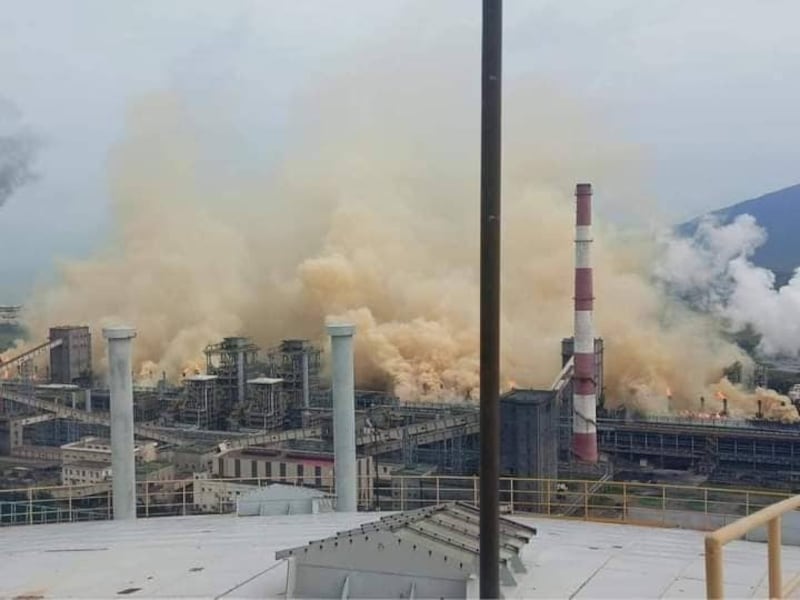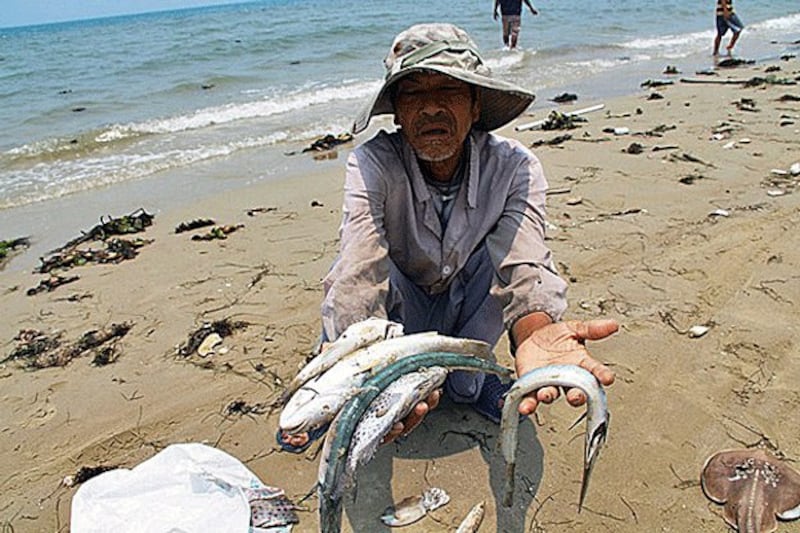The foul-smelling yellow smoke belching from the steel factory’s many chimneys was much worse than the usual fumes that Vietnamese high-school student Thanh Tam was used to.
“On that day, on the way home, I started smelling a burning smell, so I thought it might be that something was being incinerated,” said Tam, who rides his bike past the Formosa Ha Tinh Steel Corporation factory four times a day – back and forth to school and to come home for lunch.
“But when the wind hit the road, we were struck by a revolting smell, like the smell of rotten waste,” he said.
Preliminary investigations revealed the yellow smoke was caused by a fire inside the plant, the director of the provincial police department, Nguyen Hong Phong, told the state-run Industry and Trade newspaper. The Oct. 22 incident is under investigation, he said.
The Formosa factory, located in Ky Anh district, in the coastal province of Ha Tinh, has a poor reputation. In 2016, it caused Vietnam’s worst-ever environmental disaster when it discharged toxic chemicals into the ocean, devastating more than a hundred miles of coastline in four central provinces of Vietnam.
Taiwan-based Formosa Plastics Group, the primary investor in the steel plant, offered U.S.$500 million to clean up and compensate people affected by the spill, but the government has faced protests over the amount and terms of the settlement, as well as the slow pace of payouts.
Tam said the odor permeated everything in the area, even as far away as the school, about 10 kilometers (about 6 miles) from the factory, he said.
“At home, I felt as if I was going to faint because the house reeked with the smell of waste. Then at school, even inside our class, the horrible smell was still pervading,” he said. “We had to wear a mask throughout the day and only took it off at home. That smell was just everywhere.”

Authorities downplay fire
Police Director Phong said an exhaust fan in the coking workshop of the factory's energy department malfunctioned, causing a fire that spewed an opaque yellow smoke. If violations are found during the investigation, the violators will be held responsible, he said.
Authorities downplayed the severity of the fire, with Vo Trong Hai, the chairman of Ha Tinh province, telling the state-run Investors magazine that the smoke was "not a problem."
Six years after causing Vietnam’s worst environmental disaster, the factory is still disrupting the lives of people who live near it, and their surrounding environment, a resident there told RFA.
“This time, it was the dark yellow smoke, which we haven’t seen in a while,” said Mai Chau Bau, who lives a few kilometers from the steel mill. Last month the factory let out a thick black smoke, he said.
“Whenever you are on the road, the smell is very unpleasant and suffocating. But these days it has become a common thing,” he said.
Pollution from the factory has been getting worse since 2008, the year it was constructed, Bau said. It affects the air, the soil, the sea, and is detrimental to the people’s health and income.
“If you use a wash basin to collect water when it rains, you will see a layer of black coal dust on the bottom of the basin,” he said. “In the past, we could use rainwater for cooking and drinking, but we no longer dare to do so now.”

Though Formosa admitted responsibility for the 2016 disaster and paid compensation, it was paid to the Vietnamese government rather than directly to the affected people. Some of those attempted to sue Formosa through the Vietnamese courts, but their petition was denied.
The government has jailed numerous activists for protesting how the disaster and compensation had been handled, including Nguyen Van Hoa, who had been a regular contributor to RFA.
When the court sentenced Hoa to seven years in 2017, state media reported that his videos, photos, and articles about the disaster were for the purpose of “propagating against, distorting and defaming the government.” and that he “received money” from “extremists and hostile forces” to cause public disorder.
In June 2019, around 8,000 victims of the environmental catastrophe sued Formosa in a Taiwanese court for not receiving adequate compensation. The court has accepted the case, and the legal battle is still ongoing.
Translated by Anna Vu. Written in English by Eugene Whong.
